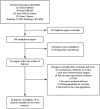Prevalence of nonsuicidal self-injury in chinese middle school and high school students: A meta-analysis
- PMID: 30335024
- PMCID: PMC6211880
- DOI: 10.1097/MD.0000000000012916
Prevalence of nonsuicidal self-injury in chinese middle school and high school students: A meta-analysis
Abstract
Recent studies have revealed a high rate of nonsuicidal self-injury (NSSI) behavior in Chinese students, but quantitative syntheses of pooled prevalence are sparse. There have been several NSSI prevalence meta-analyses in other populations. However, given the existence of cultural diversity, racial difference, educational system difference and so on, these results may not be ideal for Chinese populations. Furthermore, the above-mentioned meta-analyses did not include Chinese database which may have led to unintentional bias. Thus, we conducted this meta-analysis to estimate the prevalence of NSSI in Chinese middle-school students.The databases searched included PubMed, Embase, Web of Science, CBM (Chinese database), Chinese National Knowledge Infrastructure (CNKI), Wanfang Data (Chinese database) and the Weipu database (Chinese database). The search terms included: self-injury/self-harm/self-abuse/nonsuicidal self-injury/deliberate self-harm, adolescen*/youth/teen/students, and China/Chinese. All relevant articles published between January 2000 to November 2017, in either Chinese or English, were included. Two investigators were engaged in this process, and any disagreements were settled by a third investigator. A random effects model was then used to calculate the pooled prevalence.A total of 420 studies with 160,348 participants were retrieved. The pooled prevalence was 22.37% (95% CI: 18.84%-25.70%). Substantial heterogeneity in prevalence estimates was revealed. Subgroup analyses showed that the pooled estimate of prevalence of life time NSSI was 14.5% (95%CI: 0.06%-22.7%), and 6-24 months NSSI was23.3% (95%CI: 20.5%-26.1%). The prevalence for males was 20.6% (95% CI: 16.1%-25.0%), and for females was 21.9% (95% CI: 17.6%-26.2%).The prevalence of NSSI in Chinese middle-school students is relatively high. More attention should be paid to the current situation.
Conflict of interest statement
Competing interests: The authors declare that they have no competing interests.
Figures
Similar articles
-
A reversed gender pattern? A meta-analysis of gender differences in the prevalence of non-suicidal self-injurious behaviour among Chinese adolescents.BMC Public Health. 2017 Jul 28;18(1):66. doi: 10.1186/s12889-017-4614-z. BMC Public Health. 2017. PMID: 28754108 Free PMC article.
-
"Boy Crisis" or "Girl Risk"? The Gender Difference in Nonsuicidal Self-Injurious Behavior Among Middle-School Students in China and its Relationship to Gender Role Conflict and Violent Experiences.Am J Mens Health. 2018 Sep;12(5):1275-1285. doi: 10.1177/1557988318763522. Epub 2018 Mar 26. Am J Mens Health. 2018. PMID: 29577836 Free PMC article.
-
Prevalence of suicidal ideation in Chinese college students: a meta-analysis.PLoS One. 2014 Oct 6;9(10):e104368. doi: 10.1371/journal.pone.0104368. eCollection 2014. PLoS One. 2014. PMID: 25285890 Free PMC article.
-
The pooled prevalence and influential factors of non-suicidal self-injury in non-clinical samples during the COVID-19 outbreak: A meta-analysis.J Affect Disord. 2023 Dec 15;343:109-118. doi: 10.1016/j.jad.2023.09.036. Epub 2023 Oct 5. J Affect Disord. 2023. PMID: 37802326 Review.
-
Global prevalence of self-harm during the COVID-19 pandemic: a systematic review and meta-analysis.BMC Psychol. 2023 May 5;11(1):149. doi: 10.1186/s40359-023-01181-8. BMC Psychol. 2023. PMID: 37147683 Free PMC article.
Cited by
-
Factors influencing the addiction characteristics of non-suicidal self-injurious behaviors in adolescents: A case-control study.Front Psychiatry. 2022 Dec 1;13:1033242. doi: 10.3389/fpsyt.2022.1033242. eCollection 2022. Front Psychiatry. 2022. PMID: 36532167 Free PMC article.
-
The Prevalence, Correlates and Functions of Non-Suicidal Self-Injury in Vietnamese Adolescents.Psychol Res Behav Manag. 2021 Nov 27;14:1915-1927. doi: 10.2147/PRBM.S339168. eCollection 2021. Psychol Res Behav Manag. 2021. PMID: 34866944 Free PMC article.
-
Correlates of Non-suicidal Self-Injury in Adolescent Psychiatric Patients in China.Front Psychiatry. 2022 Jun 27;13:864150. doi: 10.3389/fpsyt.2022.864150. eCollection 2022. Front Psychiatry. 2022. PMID: 35832596 Free PMC article.
-
Network analysis of the relationship between non-suicidal self-injury, depression, and childhood trauma in adolescents.BMC Psychol. 2024 Apr 25;12(1):234. doi: 10.1186/s40359-024-01729-2. BMC Psychol. 2024. PMID: 38664781 Free PMC article.
-
Exacerbation model of cumulative adverse experiences: prevalence, characteristics, and risk factors of self-harm and suicidality among Chinese migrant workers.Front Public Health. 2025 Jun 18;13:1594466. doi: 10.3389/fpubh.2025.1594466. eCollection 2025. Front Public Health. 2025. PMID: 40606091 Free PMC article.
References
-
- Hilt LM, Cha CB, Nolen-Hoeksema S. Nonsuicidal self-injury in young adolescent girls: moderators of the distress-function relationship. J Consult Clin Psychol 2008;76:63–71. - PubMed
-
- Swannell SV, Martin GE, Page A, et al. Prevalence of nonsuicidal self-injury in nonclinical samples: systematic review, meta-analysis and meta-regression. Suicide Life Threat Behav 2014;44:273–303. - PubMed
Publication types
MeSH terms
LinkOut - more resources
Full Text Sources
Medical




